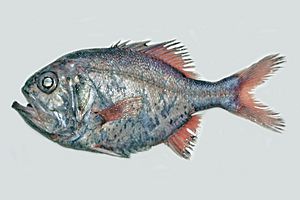Giant sawbelly facts for kids
Quick facts for kids Giant sawbelly |
|
|---|---|
 |
|
| Conservation status | |
|
Not evaluated (IUCN 3.1)
|
|
| Scientific classification | |
| Kingdom: | |
| Phylum: | |
| Class: | |
| Order: |
Beryciformes
|
| Family: |
Trachichthyidae
|
| Genus: |
Hoplostethus
|
| Species: |
H. gigas
|
| Binomial name | |
| Hoplostethus gigas McCulloch, 1914
|
|
The giant sawbelly (Hoplostethus gigas) is a really cool deep-sea fish. It's part of the slimehead family, which are known for living in the deep parts of the ocean. This fish can be found off the western and southern coasts of Australia and near New Zealand. It lives very deep, in a place called the continental slope.
Contents
What is the Giant Sawbelly?
The giant sawbelly is a medium-sized fish that lives in the deep ocean. It got its name, "sawbelly," because some fish in its family have rough, saw-like scales on their bellies. This fish was first described in 1914 by a scientist named Allan Riverstone McCulloch.
Where Does it Live?
This amazing fish calls the deep waters of the Pacific Ocean home. You can find it swimming near Australia and New Zealand. It prefers to live on the continental slope. This is the part of the ocean floor that slopes down from the shallow coastal areas into the deep sea.
The giant sawbelly lives at depths between 237 and 311 metres (778 and 1,020 ft). That's incredibly deep! Sunlight cannot reach these depths, so it's always dark and cold there. The pressure is also very high, which means these fish have special adaptations to survive.
How Big Can it Get?
The giant sawbelly can grow to be quite large for a deep-sea fish. It can reach lengths of up to 52.5 centimetres (20.7 in). That's about half a meter long! Imagine seeing a fish that big in the dark depths of the ocean.
Life in the Deep Sea
Life in the deep sea is very different from life near the surface. It's a dark, cold, and high-pressure environment. Fish like the giant sawbelly have special ways to live there. They often have large eyes to catch any tiny bit of light. Some deep-sea creatures even make their own light, called bioluminescence. This helps them find food or avoid predators.
Deep-sea fish often move slowly and have a slow metabolism. This means they don't need much energy. Food can be scarce in the deep ocean. So, they save energy by not moving around too much. They are important parts of the deep-sea ecosystem.
See Also
- In Spanish: Hoplostethus gigas para niños

